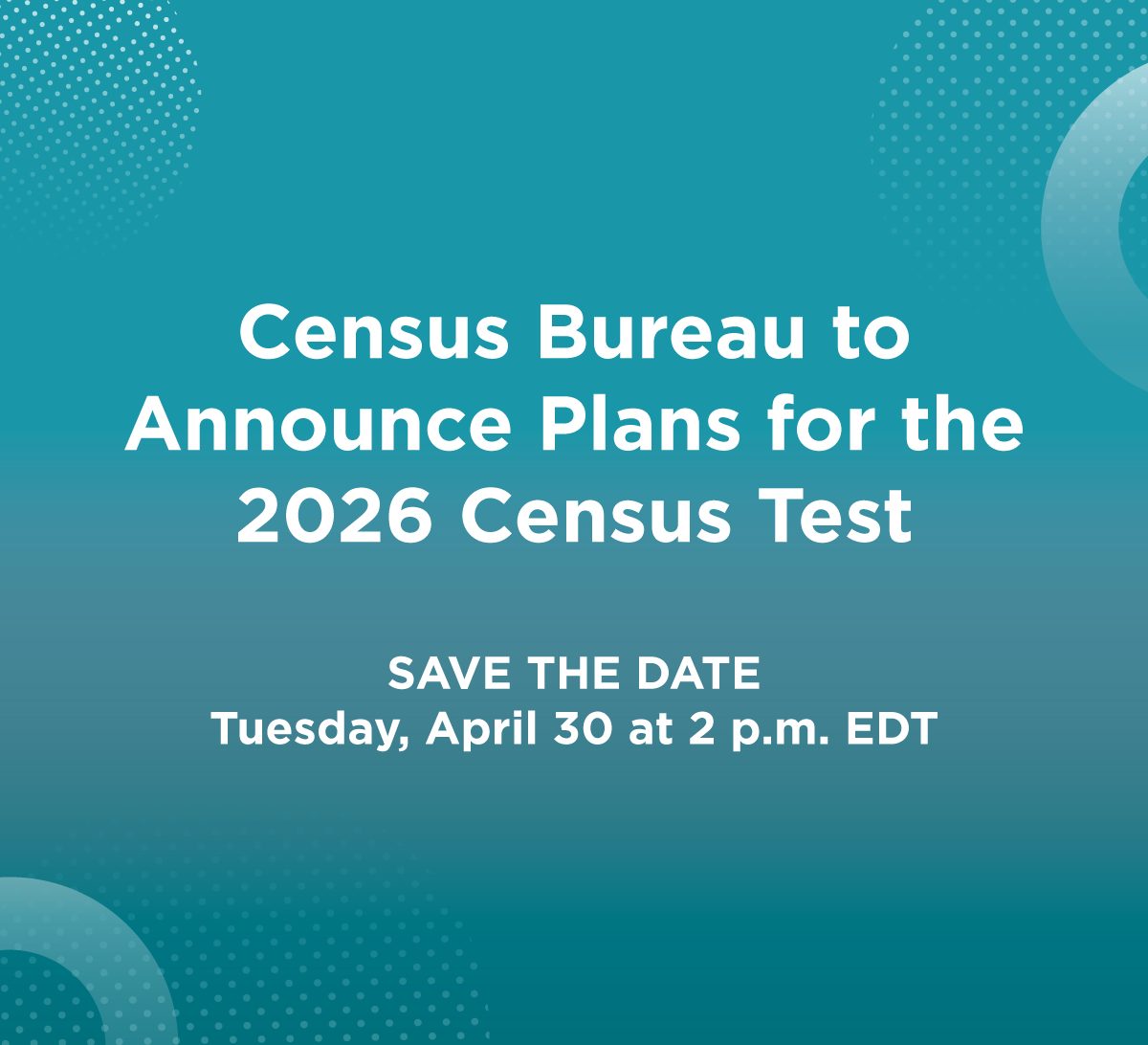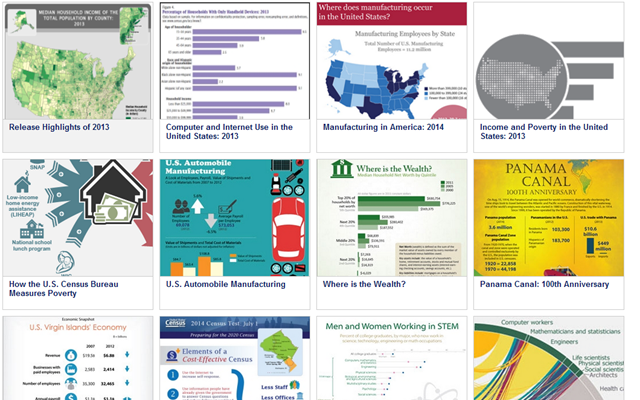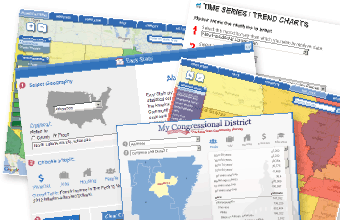Tip Sheet Number 23 — November 17, 2023
Upcoming
2023 Product Calendar
The U.S. Census Bureau has posted anticipated release dates for each regular and recurring statistical product scheduled for release in 2023. These products are listed in the Census Bureau’s online product calendar, which is updated as needed throughout the year.
American Community Survey
Census Bureau to Host Webinar on 2018-2022 American Community Survey Statistics
The U.S. Census Bureau will hold a webinar November 30 at 2 p.m. EST in advance of the December 7 release of the 2018-2022 American Community Survey 5-year estimates. The webinar will show participants how to access the new data and online resources. Attendees will also learn about changes related to this release and tips for comparing data over time. (Scheduled to take place November 30.)
Proposed 2025 American Community Survey and Puerto Rico Community Survey Content Changes
The Census Bureau is inviting public feedback through a Federal Register Notice (FRN) on proposed changes to the 2025 American Community Survey (ACS) and Puerto Rico Community Survey (PRCS). The proposed content for the 2025 ACS and PRCS reflects changes to content and instructions that were recommended as a result of the 2022 Content Test. The Census Bureau periodically conducts tests of new and revised survey content to ensure the ACS and the PRCS meet the data needs of stakeholders. The changes proposed for 2025 cover several topics: household roster, educational attainment, health insurance coverage, disability, and labor force questions. Additionally, three new questions are proposed to be added to the ACS and the PRCS on solar panels, electric vehicles, and sewage disposal. The public comment period closes December 19. For more information, visit the Content Changes webpage.
Demographic
America’s Families and Living Arrangements
The U.S. Census Bureau will release the annual Families and Living Arrangements estimates. These statistics describe trends in household and family composition and show the number of children, young adults and couples living in the United States. Data come from the 2023 Current Population Survey Annual Social and Economic Supplement, which has collected statistics on families for more than 60 years. (Scheduled for release November 21.)
Foreign Born Report
The U.S. Census Bureau will release a new report providing an overview of the foreign-born population in the United States, highlighting select demographic and socioeconomic characteristics. The report is based on American Community Survey (ACS) 1-year estimates and compares data from 2010 and 2022, providing insight into the changing composition of the foreign-born population over the past decade. (Tentatively scheduled for release November 30.)
Small Area Income and Poverty Estimates for States, Counties and School Districts
The U.S. Census Bureau will release new data on small area income and poverty estimates for states, counties and school districts. The new data come from the Small Area Income and Poverty Estimates (SAIPE) program, which provides the only up-to-date, single-year income and poverty statistics for the nation’s 3,143 counties and 13,146 school districts. (Scheduled for release December 14.)
Economic
Business Trends and Outlook Survey
The Business Trends and Outlook Survey (BTOS) measures business conditions on an ongoing basis. Beginning in September 2023, the BTOS made several changes regarding data collection and data products. BTOS experimental data products are now representative of all employer businesses in the U.S. economy, excluding farms. New questions were added to the BTOS questionnaire that address the following topics: artificial intelligence, inventories, interest rates and severe weather events. Data are now available by additional employment size classes: 1-4 employees, 5-9 employees, 10-19 employees, 20-49 employees, 50-99 employees, 100-249 employees and 250 or more employees. The data allow greater insight into the state of the economy by providing continuous, timely information for key economic measures. Data are released biweekly and are available by sector, state and the 25 most populous metropolitan statistical areas. Because of the change in sample composition, BTOS data from before September 11, 2023, are not directly comparable with data after that date.
Monthly Business Formation Statistics
Business Formation Statistics (BFS) provide timely, high-frequency data on business applications and employer business formations monthly. The data are available at the state, regional and national levels and by industry sector at the national level. The next monthly BFS will be released December 18 and include November 2023 data. Business Formation Statistics - Release Schedule (census.gov).
Stats for Stories
Stats for Stories provides links to timely story ideas highlighting U.S. Census Bureau statistics that relate to current events, observances, holidays and anniversaries. The story ideas are intended to assist the media in story mining and producing content for their respective audiences.
- National Family Week: November 19-25, 2023
- National Child’s Day & World Children’s Day: November 20, 2023
- Native American Heritage Day: November 24, 2023
- Black Friday: November 24, 2023
- Small Business Saturday: November 25, 2023
- Cyber Monday: November 27, 2023
- Illinois 205 Years of Statehood (1818): December 3, 2023
- National Miners Day: December 6, 2023
- National Pearl Harbor Remembrance Day (1941): December 7, 2023
- Bill of Rights Day (1791): December 15, 2023
- 250th Anniversary Boston Tea Party (1773): December 16, 2023
- Wright Brothers Day (1903): December 17, 2023
- National Homeless Persons’ Memorial Day (1st Day Winter): December 21, 2023
Recently Released
(Released since November 3, 2023)
National Advisory Committee 2023 Fall Meeting – November 16-17
The U.S. Census Bureau hosted the National Advisory Committee Fall Virtual Meeting November 16-17. The committee addressed policy, research and technical issues relating to a full range of Census Bureau programs and activities, including the decennial census, demographic and economic statistical programs, field operations and information technology. Last-minute changes to the schedule are possible. For more information, visit <www.census.gov/about/cac/nac/meetings/2023-11-meeting.html>.
2020 Census
2020 Census Evaluations and Experiments (EAE)
The 2020 Census Evaluations and Experiments (EAE) operation is one component of 2020 Census Data Quality efforts, designed to document and evaluate 2020 Census programs and operations, as well as to test new methods suggested from previous research. Results documented in the 2020 Census EAE operation serve as background for designing, testing, and implementing the 2030 Census. The studies consist primarily of operational assessments, but also include evaluations, experiments, quality control results, and a topic report. The list of planned studies and tentatively scheduled completion dates are available on the Census Evaluations and Experiments webpage. The first reports from these studies were released on August 18, 2022.
Demographic
2021 Survey of Income and Program Participation (SIPP) Fact Sheets
November 17 — The U.S. Census Bureau released a series of fact sheets that profile recipients of several income and support programs in the U.S. including: Child Support, Pandemic-Related Economic Impact Payments (EIPs), Social Security, School Meals, Supplemental Nutrition Assistance Program (SNAP), Supplemental Security Income (SSI), benefits for Veterans, and Special Supplemental Nutrition Program for Women, Infants, and Children (WIC). Using data for calendar year 2021 from the Survey of Income and Program Participation (SIPP), these fact sheets provide a quick and easy way to get statistics on a wide range of topics. SIPP is a nationally-representative, longitudinal survey that provides comprehensive information about income, employment, household composition, and government program participation. For more information, visit <Survey of Income and Program Participation>.
Virtual Workshop on Advancing Research on Race, Ethnicity and Inequality
November 14-15 — The U.S. Census Bureau held a virtual workshop on Advancing Research on Race, Ethnicity and Inequality November 14-15. This event brought together new perspectives on how data resources can be better leveraged to measure the dimensions of race and ethnicity within the U.S. population and to investigate ways to identify systemic race/ethnic inequalities in U.S. society. Visit this webpage for more information and to register.
2023 National Population Projections
November 9 — The U.S. Census Bureau released the 2023 National Population Projections which provide an in-depth analysis of the nation’s population looking forward to 2100, including its size and composition by age, sex, race, Hispanic origin and nativity. The 2023 projections include a main series and three alternative scenarios with varying assumptions about international migration. Spanish
Household Pulse Survey
November 8 — The experimental Household Pulse Survey is an effort by the U.S. Census Bureau and other federal statistical agencies to provide near real-time data on how the social and economic effects of the COVID-19 pandemic and other emergent issues are affecting people’s lives to inform federal and state response and recovery planning. Data collection for phase 3.10 began August 23, with data dissemination including detailed data tables and public-use data files on a monthly basis.
Same-Sex Couple Households
November 8 — The Census Bureau released updated tables and figures on the characteristics of same-sex couple households based on 2022 American Community Survey (ACS) 1-year estimates. The ACS is the leading source for community and local-level data. More information is available on the Census Bureau’s Families and Households page at <www.census.gov/topics/families/families-and-households.html>.
Economic
2021 BDS Explorer
November 16 — The U.S. Census Bureau released an update to BDS Explorer version 1.23.2, an interactive data visualization tool. The BDS Explorer provides access to the entire Business Dynamics Statistics (BDS) time series, covering the years 1978 to 2021, via line charts, bar charts, and thematic maps. The application's intuitive dashboard allows for the construction of tables and charts to compare and sort measures of business dynamism. Version 1.23.2 allows users to view “normalized” data through two new features, Index and Share. Index allows the data to be indexed back to the earliest selected year. Share allows the data user to view the percentage share of a characteristic compared to the total for all characteristics within that category.
Post-Secondary Employment Outcomes (PSEO) the Past, the Present and the Future
November 15 — The U.S. Census Bureau and the Local Employment Dynamics (LED) Partnership in collaboration with the Council for Community and Economic Research (C2ER) and the Labor Market Information (LMI) Institute presented, “Post-Secondary Employment Outcomes the Past, the Present and the Future.” Recently, the U.S. Census Bureau released data for institutions from six new data partners in the PSEO experimental data product. PSEO now includes data on 825 institutions, which cover more than 29% of all college graduates in the United States in 2015. PSEO is an experimental data product generated by linking graduate transcript records to LEHD data on graduates of participating post-secondary institutions in the United States. PSEO Explorer has been updated to display data for these new institutions.
OnTheMap Update and 2021 LODES Data
November 15 — The U.S. Census Bureau released an updated version of its Longitudinal Employer-Household Dynamics (LEHD) Origin-Destination Employment Statistics (LODES) data product. The 8.1 version of LODES add data for 2021. The OnTheMap application is updated to include these new LODES tabulations that will contain 20 years of data from 2002 to 2021. The OnTheMap for Emergency Management application is updated with data for 2021.
New Graphic Highlighting Business Owners by Veteran and Disability Status
November 9 — The U.S. Census Bureau released a new graphic from the Annual Business Survey (ABS) highlighting business owners with a disability by minority status. The Census Bureau collaborated with the Department of Labor’s Office of Disability Employment Policy, to include a question on owner disability for the first time on the 2022 Annual Business Survey. Data on owner disability is needed to understand the prevalence of disability among business owners across industries, firm size and geographies. Data are shown for the percentage of respondent business owners and are from the 2022 Annual Business Survey previously released October 26. The ABS is conducted jointly by the U.S. Census Bureau and the National Center for Science and Engineering Statistics (NCSES) within the National Science Foundation.
Facts for Features
The 2023 Winter Holiday Season
November 2 — The holiday season is a time to celebrate, reflect and give thanks. To commemorate this time of year, the U.S. Census Bureau presents the following holiday-related facts and figures from its vast collection of statistics.
American Indian and Alaska Native Heritage Month: November 2023
October 25 — To commemorate American Indian and Alaska Native Heritage Month, the Census Bureau has compiled a list of statistics about the American Indian and Alaska Native population.
America Counts: Stories Behind the Numbers
America Counts tells the stories behind the numbers in a new and inviting way. We feature stories on various topics such as families, housing, employment, business, education, the economy, emergency preparedness and the population. New stories include:
- 3- and 4-Year-Old School Enrollment Rebounds From Pandemic Low (November 14)
- World Population Estimated at 8 Billion (November 9)
- Interracial Couples More Common Among Same-Sex Couples (November 8)
- The Nation’s First Veterans and How Military Service Has Changed (November 7)
Stats for Stories
Stats for Stories provides links to timely story ideas highlighting the Census Bureau’s newsworthy statistics that relate to current events, observances, holidays and anniversaries. The story ideas are intended to assist the media in story mining and producing content for their respective audiences.
- America Recycles Day: November 15, 2023
- Geography Awareness Week & GIS Day: November 13-17 & 15, 2023
- American Education Week: November 13-17, 2023
- National STEM Day: November 8, 2023
- National Diabetes Month: November 2023
- National Aviation History Month: November 2023
- National Family Caregivers Month: November 2023
- Atlantic Hurricane Season: June 1-November 30, 2023
Blogs
New Experimental Products Designed with the AIAN Community in Mind
Written by: Dr. Sallie Ann Keller, Chief Scientist and Associate Director of the Research and Methodology Directorate
November 13 — Here at the U.S. Census Bureau, we have a long history of innovation. We’re committed to reflecting an accurate portrait of our nation, and our success depends on delivering statistics that address the needs of all our data users. Meeting our nation’s information needs through developing statistical products is an enormous task, requiring continual modernization. In the modern digital era, massive amounts of data are generated as we go about our daily lives. There are many new data sources and data science advances. There’s also an increased demand for information—data users across the nation want more timely, accurate, granular and customizable information about our people, places and the economy than ever before.
Understanding Hard-to-Count and Historically Undercounted Populations
Written by: Deborah Stempowski, Associate Director for Decennial Census Programs
November 7 — In a world driven by data, accurate population counts form the foundation for informed decision-making. As the U.S. Census Bureau prepares for the crucial task of counting our population in the next census, it’s imperative to shine a spotlight on the people and households that we have the most difficulty enumerating. In our efforts to develop the best methods to do just that, we have found it essential to conceptualize two population groups: the hard-to-count (HTC) populations and, a critical subset of those, the historically undercounted populations (HUPs).
Resources
Emergency Management/Disaster Resources — When major disasters strike, visit our Emergency Management webpage for demographic and economic data on impacted areas. Each disaster will include data from our key emergency management tools: OnTheMap for Emergency Management, Community Resilience Estimates, Census Business Builder: Regional Analyst Edition, and other useful resources.
Learn What Surveys Are Being Conducted in Your Community — Discover which of the U.S. Census Bureau’s 130-plus annual surveys are being conducted in your community. In a variety of surveys and censuses, evolving from the first census in 1790, the Census Bureau provides official information about America’s people, businesses, industries and institutions. Learn more about surveys currently being conducted in each Census Bureau region:
Data Tools
Below are a few of the U.S. Census Bureau’s interactive applications used to access statistics from our 130-plus annual surveys. A complete list can be accessed on the Census Bureau’s Data Tools and Apps webpage.
Emergency Management Hub — This portal provides quick access to demographic, economic, and resilience information for areas impacted by the latest significant emergency events in the U.S.
LED Extraction Tool — Provides easy access to the raw data products produced by the Longitudinal Employer-Household Dynamics (LEHD) program.
My Tribal Area — Access selected statistics collected for the American Indian and Alaska Native (AIAN) population from the American Community Survey (ACS).
Training Opportunities
Census Bureau Training Opportunities — Webinars are available on a regular basis to help the public access and use Census Bureau statistics. These free sessions, which are 60 to 90 minutes each, show users how to navigate Census Bureau databases and mapping tools and find demographic and economic statistics at the local or national level. Descriptions of upcoming sessions are available on our Census Academy webpage. Login details are provided at least one week before a webinar.
- 2018-2022 ACS 5-year Prerelease Webinar (Thursday, November 30, 2-3 p.m. EST)
Puerto Rico Webinar Series
This webinar series will highlight Census Bureau statistics and online resources for Puerto Rico. Topics include international trade, workforce data from Quarterly Workforce Indicator and business data from the County Business Patterns, the Business Trends and Outlook Survey and the Economic Census Island Areas. Visit the PR webinar series webpage to explore upcoming webinars.
Archived Training Resources
Visit the Census Bureau’s Educational Resource Library for previously recorded, free training available at your convenience. The library includes presentations, recorded webinars, tutorials and other helpful materials.








